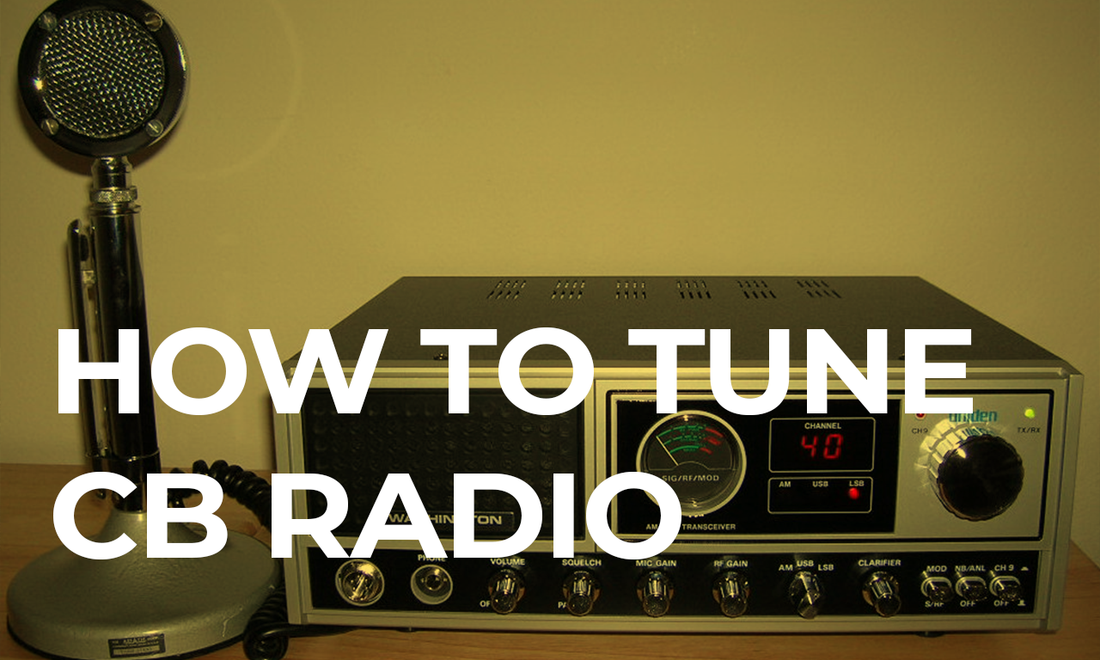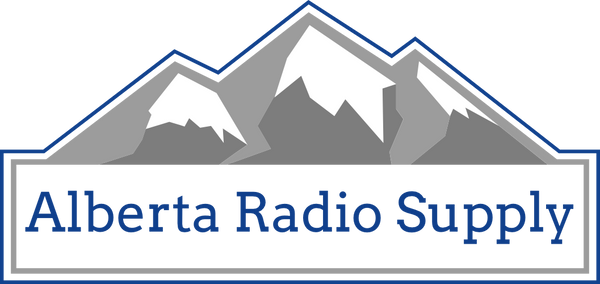
How to Tune a CB Radio: Complete Guide for Peak Performance
Share
Key Takeaways
- Tuning your CB antenna is mandatory - Not tuning can damage your radio and severely limit performance
- SWR (Standing Wave Ratio) is critical - Aim for readings below 1.5:1 for optimal performance
- You'll need an SWR meter - Built-in or external meters help measure antenna efficiency
- Small adjustments make big differences - Adjust antenna length in 1/4 inch increments
- Proper tuning increases range - Well-tuned systems transmit clearer signals over greater distances
- Regular maintenance matters - Check SWR periodically to maintain peak performance
Whether you're a professional trucker navigating cross-country routes, an off-road enthusiast exploring remote trails, or someone preparing for emergency communications, properly tuning your CB radio can make the difference between crystal-clear conversations and frustrating static. At Alberta Radio Supply, we've helped thousands of customers optimize their CB radio systems, and this comprehensive guide will walk you through everything you need to know about tuning your CB radio for maximum performance.
What is CB Radio Tuning and Why Does It Matter?
CB radio tuning is the process of adjusting your antenna system to achieve the most efficient transmission and reception of radio signals. The basic idea behind tuning a CB antenna is to get the SWR to a suitably low reading. If the SWR is too high, not only is the performance of your CB seriously hindered, but you run a very high risk of damaging your radio.
When you tune a CB radio system, you're actually tuning the antenna to your specific vehicle or installation, not tuning it to the radio itself. Tuning a CB antenna is tuning the antenna to the vehicle or application, not tuning it to the radio. This distinction is crucial because the same antenna will perform differently on different vehicles due to variations in ground plane, mounting location, and surrounding metal structures.
The Consequences of Poor Tuning
Operating an untuned CB radio system can lead to several serious issues:
- Radio Damage: High SWR readings cause power to reflect back into your radio's transmitter, potentially overheating and destroying internal components
- Reduced Range: An improperly tuned antenna may only radiate a fraction of your radio's power output
- Poor Audio Quality: Transmissions become garbled, weak, or filled with static
- Interference: Untuned systems can cause interference with nearby electronics
Understanding SWR (Standing Wave Ratio)
SWR, or Standing Wave Ratio, is the measurement that tells you how efficiently your antenna system is working. Basically, SWR tells you how efficiently your antenna is radiating the power from your CB radio. A lower SWR means less power is being reflected back to the radio and more is actually being transmitted out into the air.
What Do SWR Readings Mean?
- 1.0 to 1.5: Excellent - Your system is operating at peak efficiency
- 1.5 to 2.0: Good - Safe to operate with acceptable performance
- 2.0 to 2.5: Fair - Functional but not optimal, adjustments recommended
- 2.5 to 3.0: Poor - Risk of radio damage during extended use
- Above 3.0: Dangerous - Do not transmit, immediate adjustment required
If your SWR reading is too high then your transmit power isn't leaving through your antenna properly, and part of your radio's output power is feeding back to the radio.
Essential Tools for CB Radio Tuning
Before you begin the tuning process, gather these essential tools:
1. SWR Meter
The most critical tool for tuning is an SWR meter. You have two options:
- Built-in SWR meters: Many modern CB radios include integrated SWR meters
- External SWR meters: Standalone units like the Astatic PDC7 offer more precise readings
2. Short Coaxial Cable (Jumper Lead)
A quality jumper cable connects your SWR meter between the radio and antenna. We recommend using high-quality coax cables for accurate readings.
3. Basic Hand Tools
- Adjustable wrench or pliers
- Screwdrivers (flathead and Phillips)
- Wire cutters (for certain antenna types)
4. Clear Testing Area
Choose a clear, unobstructed location to adjust the SWR Antennas are very sensitive to objects close to them. Go to an open area to tune your antennae, such as a parking lot or remote field.
Step-by-Step Guide to Tuning Your CB Radio
Step 1: Prepare Your Testing Environment
- Find an open area at least 20 feet away from buildings, trees, or other vehicles
- Close all vehicle doors, windows, hood, and trunk
- Ensure no one is standing near the antenna during testing
- If using a magnetic mount antenna, place it in the center of your vehicle's roof
Step 2: Connect Your SWR Meter
For radios without built-in SWR meters:
- Turn off your CB radio
- Disconnect the antenna coax from the radio's antenna jack
- Connect the antenna coax to the SWR meter's "ANT" or "Antenna" port
- Connect the jumper cable from the SWR meter's "TX" or "Transmitter" port to your radio
Step 3: Calibrate the SWR Meter
Set the switch on the meter to FWD and turn the radio to a channel that's clear of transmissions. Press and hold down the microphone's talk button (aka, keying).
- Turn on your CB radio
- Set it to Channel 20 (middle of the band)
- Set the SWR meter to "FWD" or "Forward" position
- Key the microphone (press and hold the transmit button)
- Adjust the calibration knob until the needle reaches the "SET" or calibration mark
- Release the microphone button
Step 4: Take Your SWR Readings
- Switch the meter to "REF" or "Reflect" position
- Key the microphone again and note the SWR reading
- Record readings for:
- Channel 1 (26.965 MHz)
- Channel 20 (27.205 MHz)
- Channel 40 (27.405 MHz)
Step 5: Interpret Your Results
Compare your three readings:
- If Channel 1 SWR > Channel 40 SWR: Your antenna is too short
- If Channel 40 SWR > Channel 1 SWR: Your antenna is too long
- Ideal scenario: Channel 20 has the lowest reading, with channels 1 and 40 being similar
Step 6: Adjust Your Antenna
If the SWR on channel 40 is higher than that on channel 1, your antenna is too long. If the SWR on channel 1 is higher than that on channel 40, your antenna is too short.
Make adjustments based on your antenna type:
Adjustable Tip Antennas
- Turn the tuning screw in to shorten
- Turn the tuning screw out to lengthen
- Adjust in 1/4 inch increments
Whip Antennas
- Loosen the set screw
- Slide the whip up or down
- Retighten and retest
Fixed-Length Antennas
- Add a spring to increase length
- Trim the tip to decrease length (irreversible!)
Step 7: Retest and Fine-Tune
After each adjustment:
- Repeat the SWR measurement process
- Continue adjusting until you achieve the lowest possible readings
- Aim for SWR below 1.5:1 on your most-used channels
Different Types of CB Antennas and Their Tuning Methods
Fiberglass Antennas
Popular models like Firestik antennas feature adjustable tips with tuning screws. These are the easiest to tune and most forgiving for beginners.
Magnetic Mount Antennas
Magnetic mount CB antennas like the Wilson 1000 offer excellent performance when properly positioned on a metal surface with good ground plane.
Center-Loaded Antennas
These antennas have the loading coil in the middle and often require cutting the whip for tuning. Always start long and trim carefully.
Base-Loaded Antennas
With the coil at the bottom, these antennas typically use adjustable whips or tuning rings for easy adjustment.
Tuning Without an SWR Meter
While an SWR meter is strongly recommended, you can tune your antenna using an alternative method:
Even before SWR meters came about, CB radios still needed to be tuned. Most newer CB radios come with a built-in SWR meter, but that doesn't mean you'll never need to tune without one.
- Find a friend with a properly tuned CB radio
- Position both vehicles at least 40 feet apart in an open area
- Set both radios to the same channel
- Transmit from your radio while your friend listens
- Adjust your antenna length based on signal clarity
- Continue until you achieve clear, strong transmissions
Common Tuning Problems and Solutions
Problem: High SWR on All Channels
Possible Causes:
- Poor ground connection
- Damaged coax cable
- Incorrect antenna mounting
- Wrong type of coax (use 50-ohm for single antennas)
Solutions:
- Check all connections for corrosion or looseness
- Inspect coax for kinks, cuts, or crushed sections
- Ensure antenna mount has good electrical ground to vehicle chassis
- Replace damaged components
Problem: SWR Increases When Driving
Possible Causes:
- Loose antenna mount
- Intermittent ground connection
- Coax cable moving and changing impedance
Solutions:
- Secure all mounting hardware
- Route coax away from moving parts
- Use quality coax cable clips to prevent movement
Problem: Can't Get SWR Below 2.0
Possible Causes:
- Insufficient ground plane
- Antenna location interfering with performance
- Vehicle-specific challenges
Solutions:
- Try different mounting locations
- Add a ground plane kit for fiberglass vehicles
- Consider a different antenna type
- Consult with CB radio experts
Advanced Tuning Tips for Peak Performance
Dual Antenna Systems
If you're tuning dual antennas, you'll want to adjust both antennas the same amount each time. As a starting point, it's best to put the tuning screw either all the way in or out, so each antenna is the same length.
- Ensure antennas are identical models
- Mount them equidistant from the vehicle centerline
- Use a phasing harness designed for dual antennas
- Adjust both antennas equally during tuning
Ground Plane Considerations
The metal surface beneath your antenna affects performance:
- Best: Center of metal roof
- Good: Trunk lid or hood
- Fair: Fender or bumper mount
- Challenging: Fiberglass or plastic surfaces (requires ground plane kit)
Coax Cable Quality
Poor quality coax can ruin even the best antenna setup:
- Use RG-58 or better quality cable
- Keep runs as short as practical
- Avoid sharp bends or kinks
- Replace old or weathered cables
Conclusion
Properly tuning your CB radio is an essential skill that ensures clear communication, maximum range, and equipment longevity. While the process might seem technical at first, following this guide will help you achieve professional-level results. Remember that tuning is about optimizing your antenna system for your specific vehicle and installation - there's no one-size-fits-all solution.
Whether you're using your CB radio for professional trucking, recreational off-roading, or emergency preparedness, taking the time to properly tune your system will pay dividends in performance and reliability. Don't let an untuned antenna limit your communication capabilities - grab an SWR meter and start optimizing your setup today.
For all your CB radio needs, from antennas and SWR meters visit Alberta Radio Supply. Our expert team is ready to help you achieve the perfect tune for your CB radio system.
